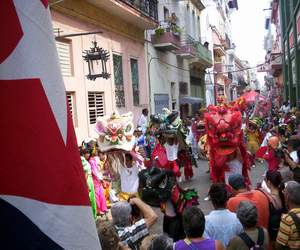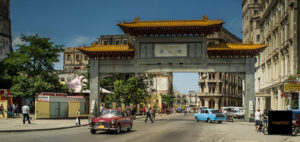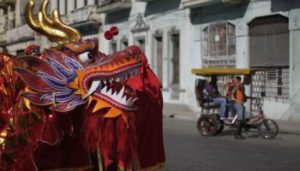Chinese societies in Cuba imitated, to a certain extent, the class and social structures of the distant Motherland and it was therefore natural that they tend to preserve their traditions and socio-cultural elements. One of the most important functions of these was to transmit the arts and culture and that is why they promoted the instruction and recreation of its members to keep alive the memory of their native China.
A case worthy of mention was the Chung Wah Yin Lock Kou Se Society which was the first to employ descendants to run the Cantonese opera. By the way Alejo Carpentier in one of his constant tours through the neighborhood he said: “If there is crisis in our theater we must recognize that Chinatown ignores it completely.” He referred to the great crisis of Cuban theater in the 1940s, in the midst of World War II.
Most researchers agree that the Min Chi Tang society was the promoter of La Danza del León in Cuba, as it was first danced in 1930 by members of the Chee Kung Tong Athletic Youth (< Min Chi Tang ), adding to the traditional festival, a tour of the most central streets of Chinatown. In 1937, thanks to the efforts of the wise Don Fernando Ortiz, this Dance is integrated to the celebrations of the Havana Carnival. The Lion Dance enjoyed great acceptance among the Cuban population, being mistakenly known as the Chinese Dragon Comparsa, however, its choreographic conception differs greatly from the Cuban comparsas.
The chroniclers of the time did not really know this dance, for they saw the lions as monsters with a grotesque face, but smiling and kind, and the performers were athletes, acrobats, who wore silver weapons, such as spears, scimitars, tridents, scythes, And wondered, are they real? On the other hand, the Chinese drums clanged, mysterious cymbals crushed the silence, the gongs and the trumpets, that the naive music that the Chinese brought from their distant country and still preserved as an inestimable treasure was heard everywhere. The wonderful carnival of millenary China which is a cult of good tradition.
In the flourishing Barrio Chino de la Habana of the years 30 – 40 there was the disappeared Society of Physical Culture “Chi Mut Hai Yut Wui”, where many young people of that time and for several consecutive generations, participated in the activities organized by this society . Here they found the right place and the desired opportunity to meet, share, recreate, play sports, learn martial arts and dance the Lion Dance. In short, it was the place that filled just the interests of youth and satisfied their impetuous energy.
The Chi Mut Hai Yut Wui Society, founded in 1926, was located at Zanja No. 255 between Bell Tower and Loyalty, had its significance in the history and further development of martial arts in Cuba. In 1932, he received his training with Wong Kei, Rufino Alay Chang, who in the beginning of 1960 would be the teacher who initiated in this discipline the group of Cubans who years later would found the Cuban School of Karate- do.
Although in other types of associations some members knew and practiced Kung Fu, Chi Mut Hai Yut Wui’s physical culture society was an institution specializing in the practice of this ancient martial art, it was the great school where teachers transferred their experiences and knowledge to The young, thus maintaining traditions from generation to generation. This society with its cultural sports traditions was lost forever and the tracks of its doing have been lost irremediably, since the last ones that had photos and data already died many years ago.
The Dance of the Lion was danced in the carnivals until in 1961, it disappeared from this famous Cuban festival, and the tradition was only kept in the intimacy (and not seldom the secret) of the societies. As a curiosity we can add that he got to dance in a show at the Tropicana cabaret by the master Mok Kan Sen (Francisco Mok).
During the Spring Festival and advent of the Lunar New Year of 1986, Min Chih Tang had the honor of being the first of its kind to re-enjoy the Chinese Lion movements again under the leadership Of Lei Choy (Rafael Li), 26 years after witnessing this demonstration for the last time. Chinese elders shed tears as they remembered their youthful years. The same situation occurred in the presentations made at the Chung Wah Nursing Home in the late 1980’s and where the elders placed a prize in the A ceiba, challenging the young to take it or give up following this dance.
One of the customs that exist around the Dance of the Lion consists in placing different heights of lettuce with a red bag and inside which a bonus is placed (Lei Si or Sun Lai). To get the lettuce, the dancers must make their acrobatic skills, without stopping to dance to the beat of the drum, without exceeding seven minutes of performance.
It is customary to place the prize in front of the entrance of a home or commercial establishment. On the other hand, the charitable influence of the Lion is also used when a hotel, a shop, a restaurant is inaugurated … All have the same objective: to attract good luck and to achieve a prosperous year, full of joy and happiness. Luckily, sun lai did not stay high.
Sociedades Chinas en Cuba. La Danza del León.
Las sociedades chinas en Cuba imitaron, en cierta medida, las estructuras clasistas y sociales de la lejana Patria y por ello fue natural que tendieran a preservar sus tradiciones y elementos socioculturales. Una de las mas importantes funciones de estas fue transmitir las artes y la cultura y por eso promovieron la instrucción y la recreación de sus miembros para mantener vivo el recuerdo de su natal China.
Un caso digno de mencionar fue la Sociedad Chung Wah Yin Lock Kou Se que fue la primera en emplear descendientes para ejecutar la opera cantonesa. A propósito Alejo Carpentier en uno de sus constantes recorridos por la barriada acotó: “Si hay crisis en nuestro teatro debemos reconocer que el Barrio Chino la ignora por completo”. Se refería a la gran crisis del teatro cubano de los años 40, en medio de la Segunda guerra Mundial.
La mayoría de los investigadores, coinciden en que la sociedad Min Chi Tang, fue la promotora de La Danza del León en Cuba, ya que se bailó por vez primera en 1930 por los miembros de la Juventud Atlética de la Sociedad Chee Kung Tong (actual Min Chi Tang), sumándose a la fiesta tradicional, un recorrido por las calles más céntricas del Barrio Chino. En el año 1937, gracias a las gestiones del sabio Don Fernando Ortiz, esta Danza se integra a las fiestas del Carnaval habanero. La Danza del León gozó de gran aceptación entre la población cubana, siendo conocida erróneamente con el nombre de Comparsa del Dragón Chino, sin embargo, su concepción coreográfica difiere mucho de las comparsas cubanas.
Los cronistas de la época desconocían verdaderamente esta danza, pues veían los leones como monstruos de cara grotesca, pero sonrientes y amables y los ejecutantes eran atletas, acróbatas, que usaban armas plateadas, tales como lanzas, cimitarras, tridentes, guadañas, entre otras, y se preguntaban, ¿son reales? Por otra parte, los tambores chinos repicaban, platillos misteriosos aplastan el silencio, los gongs y las trompetas, hacían que por dondequiera se escuchaba la ingenua música que los chinos trajeron de su lejano país y conservan aún como tesoro inestimable. El maravilloso carnaval de la China milenaria que es un culto a la buena tradición.
En el floreciente Barrio Chino de la Habana de los años 30 – 40 existió la desaparecida Sociedad de Cultura Física “Chi Mut Hai Yut Wui”, donde muchos jóvenes de aquella época y por varias generaciones consecutivas, participaron en las actividades que organizadas por esta sociedad. Aquí ellos encontraron el lugar adecuado y la oportunidad deseada de reunirse, de compartir, de recrearse, de practicar deportes, aprender artes marciales y bailar la Danza del León. En fin, fue el lugar que colmaba justamente los intereses de la juventud y satisfacía su impetuosa energía.
La Sociedad Chi Mut Hai Yut Wui, fundada en el año 1926, estuvo ubicada en la calle Zanja Nº 255 entre Campanario y Lealtad, tuvo su significación en la historia y desarrollo ulterior de las artes marciales en Cuba. En ella, a partir de 1932, recibió su formación con el maestro Wong Kei, Rufino Alay Chang, quien a principios de 1960, sería el maestro que inició en esta disciplina al grupo de cubanos que años más tarde fundarían la Escuela Cubana de Karate-do.
Aunque en otros tipos de asociaciones algunos miembros conocían y practicaban Kung Fu, la sociedad de cultura física Chi Mut Hai Yut Wui fue una institución especializada en la práctica de este antiguo arte marcial, fue la gran escuela donde los maestros trasladaban sus experiencias y conocimientos a los jóvenes, manteniéndose de esta forma las tradiciones de generación en generación. Esta sociedad con sus tradiciones deportivas culturales se perdió para siempre y las huellas de su hacer se han perdido irremediablemente, pues los últimos que poseían fotos y datos ya fallecieron hace muchos años.
La Danza del León se bailó en los carnavales hasta que en 1961, desapareció de esta famosa fiesta cubana, y la tradición sólo se mantuvo en la intimidad (y no pocas veces el secreto) de las sociedades. Como curiosidad podemos agregar que llegó a bailarse en un espectáculo en el cabaret Tropicana por el maestro Mok Kan Sen (Francisco Mok).
Durante la Fiesta de Primavera y advenimiento del Nuevo Año Lunar de 1986, la Min Chih Tang tuvo el honor de ser la primera de su tipo en volver a disfrutar de los movimientos del León Chino, nuevamente bajo la dirección de Lei Choy (Rafael Li), 26 años después de haber sido testigos de esta manifestación por última vez. Ancianos chinos derramaban lágrimas al recordar sus años de juventud, igual situación ocurrió en las presentaciones que se hicieron en el Hogar de Ancianos Chung Wah en los años finales de la década de los 80’s y donde, los mas ancianos ubicaron un premio en la copa de una ceiba, retando a los jóvenes a tomarlo o desistir de seguir esta danza.
Una de las costumbres que existen en torno a la Danza del León consiste en colocar a distintas alturas mazos de lechuga con una bolsita roja y en cuyo interior se coloca una gratificación (Lei Si o Sun Lai). Para obtener la lechuga los bailarines deben hacer galas de sus habilidades acrobáticas, sin dejar de bailar al compás del tambor, sin que sobrepasen los siete minutos de realización.
Se acostumbra a situar el premio frente a la entrada de algún hogar o establecimiento comercial. Por otro lado también se hace empleo de la influencia benéfica del León cuando se inaugura un hotel, una tienda, un restaurante… Todos tienen el mismo objetivo: atraer la buena suerte y lograr un año próspero, lleno de dicha y felicidad. Por suerte, el sun lai no quedó en las alturas.
Agencies/Monografías/Carlos Alay Jo/Julio Hun, La Habana/Extractos/ Internet Photos/ Arnoldo Varona/ TheCubanHistory.com
THE CUBAN HISTORY, HOLLYWOOD.











